
International Research Journal of Engineering and Technology (IRJET) e-ISSN: 2395-0056
Volume: 12 Issue: 02 | Feb 2025 www.irjet.net p-ISSN: 2395-0072


International Research Journal of Engineering and Technology (IRJET) e-ISSN: 2395-0056
Volume: 12 Issue: 02 | Feb 2025 www.irjet.net p-ISSN: 2395-0072
Karthik Kamarapu1 , Kali Rama Krishna Vucha2
1Independent Software Researcher, Osmania University, Hyderabad, TG, India
2Independent Software Researcher, Acharya Nagarjuna University, Guntur, AP, India
Abstract - The integration of machine learning in health care has great benefits including improved patient outcomes, early disease detection and efficient resource management. However, strict privacy regulations and the decentralized nature of the healthcare present significant challenges to centralized model training. This research proposes a novel Privacy-PreservingCollaborative Learning Framework that leverages Federated Learning (FL) for decentralized training of machine learning models across healthcare institutions and Advanced privacy-preserving techniques such as differential privacy and homomorphic encryption ensure data confidentiality during the collaboration process. This framework also incorporates Explainable AI(XAI) tools to provide interpretability to clinicians and administrators. Experimental evaluations on benchmark datasets demonstrate the framework’s high predictive accuracy while addressing data heterogeneity, scalabilityandadversarialrobustness.
Key Words: Federated Learning, Privacy Preservation, HealthcareData,ExplainableAI,DataCollaboration
The rapid adoption of digital health records and IoTenabled medical devices has created opportunities for improving clinical decision-making and operational efficiency. Machine learning models has proven effective in tasks such as disease prediction and resource optimization. However, privacy concerns and stringent regulationslikeHIPAA and GDPRrestrictcentralizeddata aggregation, creating significant barriers for traditional MLapproachesinhealthcare.[1],[2]
Federated Learning has emerged has promising alternative that enables decentralized model training allowing institutions to collaboratively learn without sharing raw data. [3], [4] However, some challenges remain such as data is often heterogeneous with variations in distribution, quality and representation across institutions. Additionally, lack of interpretability in many FL-based models hinders clinical adoption as decision makers require explanations for predictions to ensure trust. [5] Furthermore, malicious participants injectingcompromisedupdatescandangertheintegrityof theglobalmodel.[6]
To address these challenges, this research proposes a Privacy-PreservingCollaborativeLearningFramework for
health care applications which integrates advanced privacy-preserving mechanisms such as differential privacy and homomorphic encryption for securing model updates during transmission. Explainable AI(XAI) techniques such as SHAP (SHapley Additive exPlanations) are incorporated to provide actionable insights and improve model interpretability. [7] Adaptive aggregation methods address data heterogeneity and ensures robust modelperformanceacross non-IIDdatadistributions.The framework is designed to operate efficiently at scale supporting numerous institutions with minimal communicationoverhead.[8]
Experimental evaluations using benchmark datasets including MIMIC-III and PhysioNet demonstrate the framework’sefficiencyinreal-worldscenarios.Keyresults include high predictive accuracy, reduced privacy risks andenhancedmodelinterpretability.
The Federated Learning Architecture introduces a decentralized approach to training machine learning models that enables individual entities to build a global model in collaboration with each other while keeping the sensitive data locally. In the health care domain, this architecture is addressing privacy concerns by ensuring data security and complying with regulations like HIPAA andGDPRandbyleveragingFL,healthcareinstitutionscan share knowledge without compromising patient confidentiality. This section will delve into the details of thisarchitecture.
Local Training Nodes: Each health care institution participating in the federated learning process acts as a local node. Within these nodes, the data never leaves premisesensuringprivacyandregulatorycompliance.The process begins with data pre-processing where features such as patient demographics, laboratory results and physiological signals are normalized and encoded to preparethemformodeltraining.
Min-Max Normalization: Used for scaling continuous features,suchasageorlaboratorytestresultstoaspecific range(e.g.,[0,1]).

Volume: 12 Issue: 02 | Feb 2025 www.irjet.net p-ISSN: 2395-0072
One-Hot Encoding: Applied to categorical variables like disease type or medical codes to make them compatible withmachinelearningmodels.
Imputation: Handles missing data using techniques like median imputation for continuous features and mode imputationforcategoricalfeatures.
Afterpre-processing,themachinelearningmodelsrandom forests, is trained locally. During this phase, forward and backward propagation techniques are applied and the models optimize parameters using algorithm Stochastic Gradient Descent (SGD). Once the training is complete the models compute the gradients (weight updates) that represent the learning improvements for the specific local dataset. These updates are then encrypted to preserve privacy before transmitting to the central aggregation serverwhereaggregationisperformedinthenextstepsof thisframework.
CentralAggregationServer:Thecentralaggregationserver orchestrates the collaborative training process across nodes. It receives encrypted model updates from the local nodes and aggregates them using Federated Averaging, equationbelow.
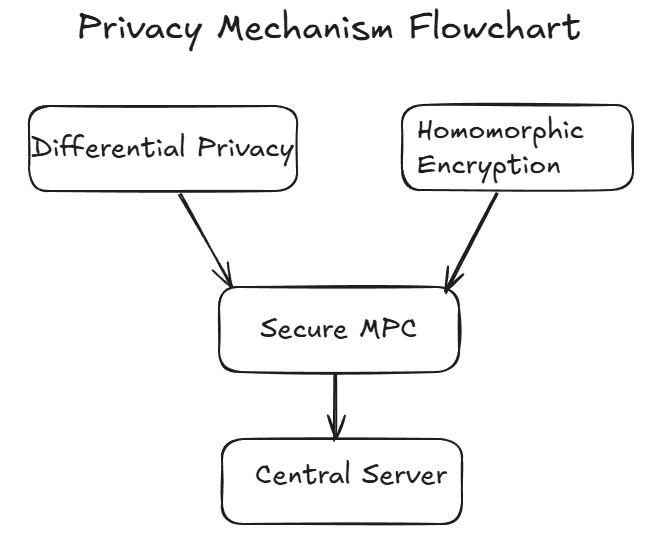
Homomorphic encryption, Paillier CryptoSystem used for encrypting gradients, secures the updates during transmission that enables computations to be performed directly on encrypted data without requiring decryption. Additionally, secure multi-party computation, using Shamir’sSecretSharingtechnique,ensuresthattheserver can aggregate updates without accessing individual contributions. The updates are split into shares and distributedtomultiplepartieswhichcollectivelycompute thesumwithoutrevealingindividualdata.
In the above equation represents the weights from node i, is the dataset size of node i and D is the total dataset across all nodes. This approach ensures fairness by giving larger datasets more influence on the global model.
Thisaggregationprocesscombinesthecontributionsofall participating nodes to refine the global model. After updating the global model, the server redistributes it to thenodesforfurtherlocaltraininginitiatingnextroundof the iterative process. This setup ensures continuously improvement of the global model while maintaining the privacyoftheindividualcontributors.
Privacy Mechanisms: This framework incorporates advanced privacy-preserving techniques to secure data during the collaborative learning process. Differential privacy is applied by adding controlled noise to local model updates that ensures the individual data points cannotbereconstructedfromaggregatedresults.
Communication Protocol: The framework uses Federated gRPC, a high-performance remote procedure call framework to facilitate communication between local nodes and central server. gRPC is chosen for its efficient serialization (using Protocol Buffers) and support for bidirectional streaming which allows for real-time communication and model updates. For asynchronous updates, the Federated Asynchronous Stochastic Gradient Descent(FedAsync)protocolisimplemented.
Adaptive Aggregation: To handle data heterogeneity across health care institutions the framework employs adaptive aggregation mechanism based on CO-OP (Collaborative Optimization) which is an extension of Fed Avg. CO-OP dynamically adjusts the weights assigned to the updates based on the data quality, i.e. updates form nodes with high-quality datasets (measure by low noise) are weighted more heavily, and training accuracy, i.e. nodes achieving higher local validation accuracy are prioritizedtoensuretheglobalmodelgeneralizeswell.

International Research Journal of Engineering and Technology (IRJET) e-ISSN: 2395-0056
Volume: 12 Issue: 02 | Feb 2025 www.irjet.net p-ISSN: 2395-0072
The federated learning process begins with the initialization of a global model by the central server. The workflowisasfollows:
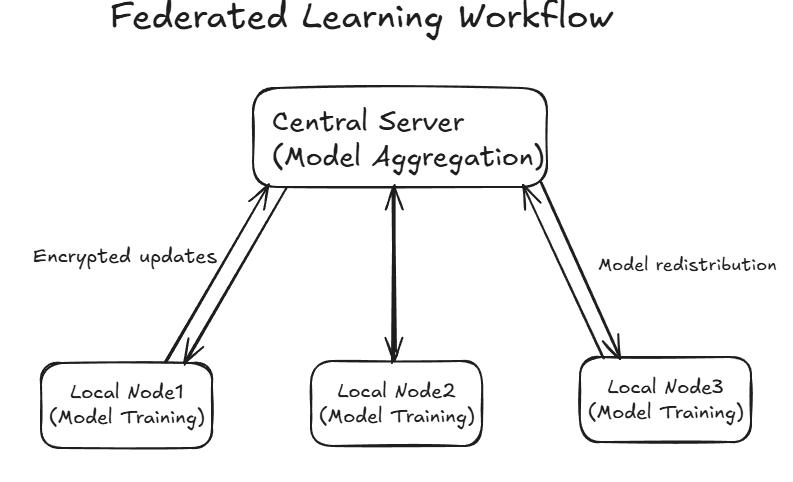
Fig. 2 FederatedLearningWorkflow
Model Initialization: The global model is initialized with random parameters and distributed to participating nodes.
Local Training: Each node trains the model locally on its dataset for a predefined number of epochs using Stochastic Gradient Descent (SGD) with techniques like batchnormalization.
Update Encryption and Transmission: Gradients are encrypted using the Paillier Cryptsystem and transmitted tothecentralserver.
Global Aggregation: The server aggregates updates using FedAvgorCO-OPandupdatestheglobalmodel.
Model Redistribution: The refined global model is sent backtothenodesforthenexttrainingiteration
Explainability: Explainability is a crucial part of this framework and to achieve this the framework integrates Explainable AI(XAI) techniques SHapley Additive exPlanations (SHAP) which provides a detailed understanding of the contributions of the individual featurestomodel predictions.Thissectiondetailsonhow global and local explainability tools are used and applied within the federated learning process to improve trust in clinicaldecision-making.
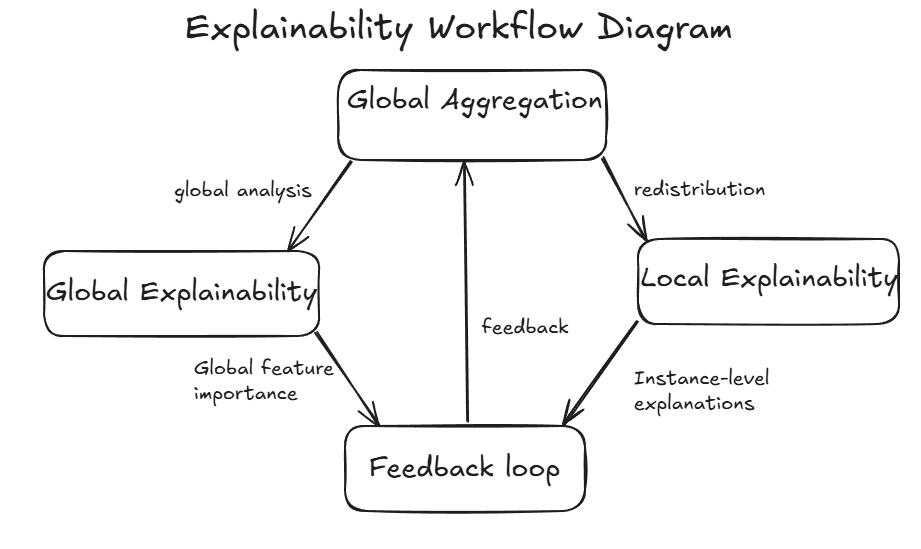
Global Explainability: This provides and aggregated view of the model’s decision-making process across all the participating nodes. The SHAP framework is used to compute the contribution of each feature to the model’s predictions. In the context of ICU mortality prediction using the MIMIC-III dataset features such as age, mean arterial pressure, oxygen saturation and lactate levels are identified as the most significant determinants. For arrhythmia detectiononthe PhysioNetdataset,important features include heart rate variability, QRS complex duration and ST segment elevation. SHAP summary plots are used to visualize the contributions of all features, highlighting their mean absolute SHAP values. These plots aggregate insights across all data points and nodes that makes it easier to understand which features consistently impact model predictions.
Local Explainability: Local Explainability focuses on interpretingindividualpredictionsbyprovidingadetailed breakdown of feature contributions for specific instances. For example, if a model predicts that a patient has a 70% likelihoodofreadmission,SHAPforceplotsshowwhether variables like recent ICU stay (positive impact) or normal glucoselevels(negativeimpact)influencedtheprediction. SHAPforceplotsdepictthecontributionofeachfeatureto the overall prediction score of an individual patient. For example, the plot may show that abnormal heart rate variabilitycontributes+0.15toapredictionwhilearecent discharge contributes –0.10. These plots are calculated using the trained model’s output and the specific feature valuesforagivenpatient.
Explainability Integration Workflow: Explainability is deeply integrated into the federated learning pipeline. After the central server aggregates model updates from localnodes,SHAPvaluesarecomputedforglobalmodelto generatebothglobalandlocalexplanations.

International Research Journal of Engineering and Technology (IRJET) e-ISSN: 2395-0056
Volume: 12 Issue: 02 | Feb 2025 www.irjet.net p-ISSN: 2395-0072
GlobalfeatureimportanceiscomputedbyaveragingSHAP values across all samples and nodes. For example, in an ICU mortality prediction task, the global SHAP summary plotwouldshowthatageandbloodpressureconsistently influencepredictions.
For case-specific predictions, SHAP force plots are generated for instances of interest. For example, patients flaggedashighrisk.Theseexplanationsarevisualizedand sharedwithcliniciansforvalidation.
Feedback Loop: Insights from explainability analysis inform next rounds of training. For instance, if certain featuresshowhighimportancebutlowconsistency,nodespecific preprocessing or feature engineering can be improvedtoenhancethemodel’sperformance.
The experimental setup was designed to evaluate proposed Privacy-Preserving Federated Learning Frameworkinacontrolledenvironmentthatissimilartoa real-worldhealthcarescenarioandinvolvedconfiguration datasets,infrastructureandprivacymechanismstoensure accurate and reliable performance measurement. The experiments focused on the areas of predictive performance, privacy preservation and scalability across multiplenodes.
Below widely used datasets are used to evaluate the framework:
MIMIC-III Dataset: This dataset provides detailed ICU patient records including demographic information, vital signs and clinical interventions. Th task focused on predicting patient mortality. Features such as age, blood pressureandoxygensaturationwerepre-processedusing min-maxnormalizationtoensureuniformityacrossnodes.
PhysioNetDataset: This dataset captures physiological signs that include ECD data from wearable devices. This task involved detecting arrhythmias based on time-series data. Key features such as heart rate variability and ST segment elevation were extracted and encoded as inputs forthemodels.
Each dataset was partitioned into non-independent and identically distributed (non-IID) subsets to emulate the diversity of data across healthcare institutions. For instance,certainnodeswereassigneddatasetswithhigher proportionsofolderpatientsandothershaddata skewed towardyoungerpatients.
The experimental environment was deployed on a distributed system to simulate multiple healthcare
institutions participating in federated learning. The setup includesthefollowing:
Central Aggregation Server: A dedicated server with configuration of 32 vCPUs, 128 GB RAM and 10 Gbps network connectivity. This server orchestrated model updates, aggregation and redistribution during training rounds
Local Nodes: Each node represented a health institution with private datasets and were with configuration with 8 vCPUs, 32GB RAM and independent storage. Docker containers were used to simulate the decentralized architecture and ensures the data raw data did not leave thenode.
Communication Protocol: A secure communication protocol based on gRPC with TLS encryption was implemented that ensure secure transmission of encrypted model updates between nodes and the central server.
ModelConfigurationandTraining:Themodelconsistedof an input layer matching the number of features in each dataset,twodensehiddenlayers(64and32neurons)and an output layer suitable for binary classification. The training used the Adam Optimizer with a learning rate of 0.0001andcross-entropyloss.Eachnodetrainedthelocal model for five epochs per round followed by and aggregation phase at the central server. This process was repeated for 30 rounds. To ensure robust evaluation, the federated averaging algorithm was employed for model aggregation. Weights from nodes were aggregated proportionatetothesizeofthequalityoftheirdatasets.
Privacy Mechanisms: The privacy-preserving techniques were integrated into the framework to ensure data security and compliance with HIPAA and GDPR. For differential privacy, Gaussian noise was added to local gradients before transmission which was controlled to balanceprivacyandmodelutility.
Encryptedgradientsallowedthecentralservertoperform aggregation without accessing raw updates and aggregation was performed using SMPC protocols to preventdataleakage.
The experimental results focus on evaluating the performance of the Privacy-Preserving Federated LearningFrameworkintermsofpredicationaccuracyand privacypreservation.
Federated Learning Layer Results: This layer was evaluated based on its ability to generate a robust global model thatgeneralizeswell acrossnon-IIDdatasetsofthe nodes. The global model achieved an accuracy of 96.1%

International Research Journal of Engineering and Technology (IRJET) e-ISSN: 2395-0056
Volume: 12 Issue: 02 | Feb 2025 www.irjet.net p-ISSN: 2395-0072
forICUmortalitypredicationontheMIMIC-IIIdatasetand 94.8%forarrhythmia detection on the PhysioNetdataset. To evaluate the frameworks’ scalability, the number of participatingnodesfromincreasesfrom10to100andthe global model maintained high accuracy and precision across configurations even as heterogeneity of data increased.
Table 1. MetricsforPredictivePerformanceonMIMIC-III dataset
Privacy Preservation: This privacy-preserving mechanisms were evaluated through simulated adverse scenarios including gradient inversion and model reconstruction attacks. The framework integrated differentialprivacyandhomomorphicencryption.
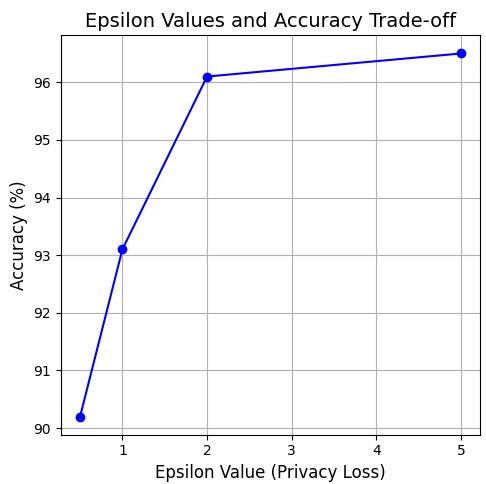
Fig. 4 Tradeoffanalysisbetweenaccuracyandprivacy
The framework achieved an epsilon value of 2.0 striking a balance between privacy and utility. At this level, the global model retained an accuracy of 96.1% for ICU mortality prediction and 94.8% for arrhythmia detection. A trade off analysis is indicated in the chart above. Homomorphic encryption successfully prevented unauthorized access to model updates during transmission. Simulation of adverse attacks such as gradient inversion confirmed the robustness of this mechanism. Secure Multi-Party Computation (SMPC) ensured aggregation process was performed without revealingindividualupdates.
Table 2. Attacktypevssuccessrate
AttackType Success Rate PrivacyMechanism
GradientInversion 0.2
Differential Privacy, Homomorphic Encryption
Model Reconstruction 0.3 Homomorphic Encryption
UpdateTampering 0 Secure Multi-Party Computation
Scalability: This was tested by varying the number of nodesfrom10to100. Thetablebelowshowsthetraining latencyandmodelconvergencetime
Table 3. Metricsbynodes
Explainability Results: Global Explainability identifies the global feature importance. The SHAP summary plot for ICU mortality prediction task using the MIMIC-III highlightedthemostimportantfeaturessuchasage,blood pressureandoxygensaturation.
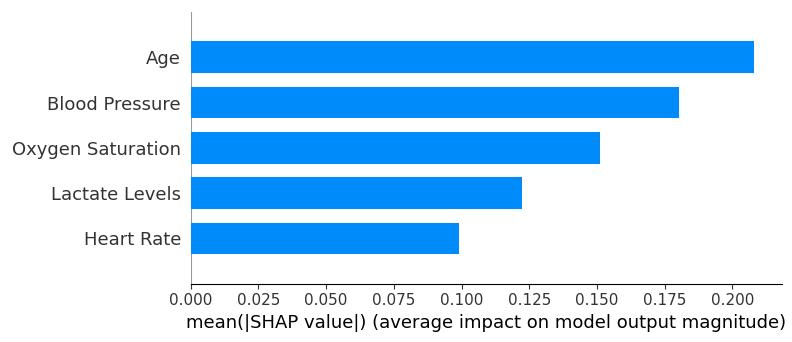
Fig. 5 SHAPsummarytable
Local explainability examines individual predictions. For example,a high-risk predictionforpatientwasinfluenced by low oxygen saturation and elevated lactate levels. Belowtableprovidesinstance-levelinsights.

International Research Journal of Engineering and Technology (IRJET) e-ISSN: 2395-0056
Volume: 12 Issue: 02 | Feb 2025 www.irjet.net p-ISSN: 2395-0072
Table 4. Instance-LevelInsightsTable
Feature
The proposed framework Privacy-Preserving Federated Learning Framework addresses critical challenges in collaborative health care data analytics by combining robust predictive performance, advanced privacypreserving techniques and explainability. The experimentalresultsdemonstratetheframeworkachieves comparable or superior accuracy to centralized models while adhering to compliances of HIPAA and GDPR. By leveraging differential privacy, homomorphic encryption and security multi-party computation the framework ensure that sensitive patient data remain secure through thefederatedlearningprocess.
Thescalabilitytestsconfirmedthatframework’sability to support large number of institutions and additionally the integration of explainable AI techniques enhanced trust and usability by provided both global and local insights intomodelpredictions.Theexplainabilitytoolsbridgethe gap between AI-driven decision-making and clinical adoption.
Future research will focus on further optimizing communication efficiency and enhancing robustness against adverse attacks and exploring new uses cases for federatedlearningbeyondhealthcare.
F.Wang,"Privacy-preservingcollaborativemodellearning scheme for E-healthcare," in IEEE Transactions on Medical Computing, 2019. [Online]. Available: https://ieeexplore.ieee.org/
M. Hao, "Privacy-aware and resource-saving collaborative learning for healthcare in cloud computing," in IEEE Transactions on Cloud Computing, 2020. [Online]. Available:https://ieeexplore.ieee.org/
Y. Gong, "Privacy-preserving collaborative learning for mobile health monitoring," in IEEE Transactions on Information Forensics and Security, 2015. [Online]. Available:https://ieeexplore.ieee.org/a
S.Gupta,"Collaborativeprivacy-preservingapproachesfor distributed deep learning using multi-institutional data,"inRSNAPublications, 2023.[Online].Available: https://pubs.rsna.org/
N. Mohamed, "Explainable AI for privacy-preserving federated learning in healthcare," in Journal of Artificial Intelligence in Medicine, 2022. [Online]. Available:https://www.sciencedirect.com/s
Z.AbouElHouda,"Whencollaborativefederatedlearning meets blockchain to preserve privacy in healthcare," in IEEE Blockchain Journal, 2022. [Online]. Available: https://ieeexplore.ieee.org/
B. Bala and S. Behal, "AI techniques for IoT-based DDoS attack detection: Taxonomies, comprehensive review and research challenges," in Journal of Network and Computer Applications, 2024. [Online]. Available: https://www.sciencedirect.com
F.Liu,"Secureaggregationtechniquesforrobustfederated learning in healthcare," in ACM Computing Surveys, 2023.[Online].Available:https://dl.acm.org/